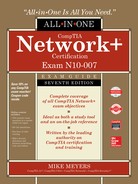Book Description
Thoroughly revised for the new CompTIA Network+ exam, the Seventh Edition of this bestselling All-in-One Exam Guide delivers 100% coverage of the exam objectives and serves as a valuable on-the-job reference
Take the latest version of the CompTIA Network+ exam with complete confidence using the fully updated information contained in this comprehensive self-study system. The book offers clear instruction and real-world examples from training expert and bestselling author Mike Meyers along with hundreds of accurate practice questions.
Fulfilling the promise of the All-in-One series, this complete reference serves both as a study tool and a valuable on-the-job reference that will serve readers beyond the exam. CompTIA Network+ Certification All-in-One Exam Guide, Seventh Edition (Exam N10-007) also includes access to free video training and interactive hands-on labs and simulations that prepare you for difficult performance-based questions. A valuable pre-assessment test enables readers to gauge their familiarity with the test’s objectives and tailor an effective course for study.
· Contains complete coverage of every objective for the CompTIA Network+ Certification exam
· Written by CompTIA training and certification guru Mike Meyers
· Electronic content includes the Total Tester exam simulator with over 100 practice questions, over an hour of training videos, and a collection of Mike Meyers’ favorite shareware and freeware networking utilities
